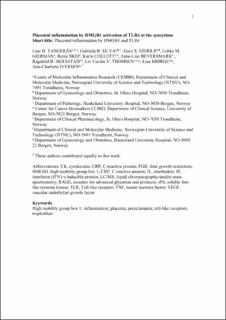Placental inflammation by HMGB1 activation of TLR4 at the syncytium
Tangerås, Line Haugstad; Silva, Gabriela; Stødle, Guro; Gierman, Lobke; Skei, Bente; Collett, Karin; Beversmark, Anne Lise; Skråstad, Ragnhild Bergene; Thomsen, Liv Cecilie Vestrheim; Bjørge, Line; Iversen, Ann-Charlotte
Peer reviewed, Journal article
Accepted version

Åpne
Permanent lenke
https://hdl.handle.net/11250/2656297Utgivelsesdato
2018Metadata
Vis full innførselSamlinger
- Institutt for klinisk og molekylær medisin [3528]
- Publikasjoner fra CRIStin - NTNU [38070]
- St. Olavs hospital [2505]
Sammendrag
Introduction: Normal pregnancy is characterized by an elevated inflammatory state
involving the placenta. The placental inflammation is further increased in preeclampsia,
resulting in release of harmful danger signals to the maternal circulation. Activation of
toll-like receptors (TLR)2 and TLR4 by endogenous danger signals plays a role in
inflammatory diseases. Placental TLR2 and TLR4 expression has been reported, and
high mobility group box 1 (HMGB1) is a likely endogenous activator of these receptors.
We aimed to examine HMGB1 activation of TLR2 and TLR4 as mechanisms of
placental inflammation in normal and preeclamptic pregnancies, by combined analysis
of expression and function of the ligand HMGB1, the receptors TLR2 and TLR4, and
the cytokine responder interleukin (IL)-8. Methods: Protein expression was analyzed in placental tissue from normal and preeclamptic pregnancies, and cytokine responses to two distinct HMGB1 isoforms
3 were examined in placental explants and trophoblasts. Inflammatory and antiangiogenic markers were measured in maternal serum. Results: We demonstrated strong co-localized expression of HMGB1, TLR4 and IL-8 in the syncytium layer of the placenta. Syncytium TLR4 expression and maternal serum
levels of IL-8 were significantly increased in preeclamptic compared to normal pregnancies. Functionality was confirmed by TLR4-dependent release of IL-8 from placental explants and tophoblasts in response to the inflammatory isoform of HMGB1. Discussion: This demonstrates a role for the HMGB1-TLR4 pathway at the syncytium layer and suggests involvement in placental inflammation and preeclampsia.